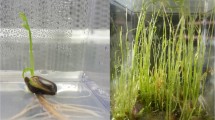Abstract
More than one third of the USA’s federally listed endangered and threatened plants are endemic to Hawaii. Because of the accelerating rate of environmental pressures resulting from habitat degradation to loss, the Hawaiian Rare Plant Program (HRPP, Lyon Arboretum, Honolulu, Hawaii) utilizes in vitro culture and seed storage to rescue, recover, and restore Hawaii’s most critically endangered native plant taxa. These in vitro methods complement existing ex situ and in situ efforts in the state. Wild-collected seeds tend to be hard to clean, and obtaining contamination-free seeds or embryos without damage or over sterilization is one of the most difficult obstacles in the successful establishment of in vitro cultures. Loss of rare and valuable propagation material occurs when seed samples succumb to contamination or mortality during the initial disinfestation stage. This study reviews pre-treatments and provides examples of three general disinfestation protocols successfully used in the HRPP to establish axenic ovule and embryo cultures of some endangered Hawaiian species. Three disinfestation protocols are described: bleach sterilization, gas sterilization, and ethanol dip and flame. Since 1998, the HRPP has been successful in establishing in vitro cultures of 135 endangered Hawaiian plant taxa representing 30 genera.





Similar content being viewed by others
References
Ali N.; Mulwa R.; Norton R.; Skirvin R. Radical disinfestations protocol eliminates in vitro contamination in Guava (Psidium guajava L.) seeds. Plant Cell Tiss Organ Cult 91: 295–298; 2007.
Baskin C.; Baskin J. Seeds-ecology, biogeography, and evolution of dormancy and germination. Academic, San Diego; 1998.
Bonga J. M.; Von Aderkas P. In vitro culture of trees. Kluwer, Dordrecht; 1992.
Bridgen M. A review of plant embryo culture. Hort Sci 29: 1243–1246; 1994.
Bunn E.; Turner S.; Panaia M.; Dixon K. The contribution of in vitro technology and cryogenic storage to conservation of indigenous plants. Aust J Bot 55: 345–355; 2007.
Chapin M. H.; Wood K. R.; Perlman S. P.; Maunder M. A review of the conservation status of the endemic Pritchardia palms of Hawaii. Oryx 38: 273–281; 2004.
Dodds J. H. Introduction: conservation of plant genetic resources-the need for tissue culture. In: Dodds J. H. (ed) In vitro methods for conservation of plant genetic resources. Chapman and Hall, London, pp 1–9; 1991.
Fay M. Conservation of rare and endangered plants using in vitro methods. In Vitro Cell Dev Biol 28P: 1–4; 1992.
Gamborg O. L.; Davis B. P.; Stahlut R. W. Somatic embryogenesis in cell cultures of Glycine species. Plant Cell Rep 2: 209–212; 1983.
George E. Plant propagation by tissue culture, part 1, The technology. Exegetics Ltd., Westbury, UK; 1993.
Guarino L.; Ramanatha Rao V.; Reid R. Collecting plant genetic diversity-technical guidelines. CAB International, Oxon; 1995.
Koob G. Conservation of Hawaiian lobelioids-in vitro and molecular studies [dissertation]. Univ of Hawaii, Honolulu; 1996.
Lamoureux C. H. Conserving Hawaiian biodiversity-the role of Hawaiian botanical gardens. In: Peng C.-I.; Chou C. H. (eds) Biodiversity and terrestrial ecosystems. Institute of Botany, Academia Sinica Monograph Series, Taipei, pp 55–57; 1994. 14.
Lloyd G.; McCown B. Commercially feasible micropropagation of mountain laurel, Kalmia latifolia, by use of shoot-tip culture. Proc Intern Plant Prop Soc 30: 421–427; 1980.
Maunder M.; Higgens S.; Culhame A. Neither common nor garden: the garden as a refuge for threatened plant species. Curtis’s Bot Mag 15: 124–132; 1998.
Murashige T.; Skoog F. A revised medium for rapid growth and bioassay with tobacco tissue culture. Physiologia Plantarum 15: 473–497; 1962.
Palmer D. D. Hawaii’s ferns and fern allies. University of Hawaii Press, Hawaii, USA; 2003.
Paunescu A. Biotechnology for endangered plant conservation: a critical overview. Romanian Biotech Let 12: 4095–4103; 2009.
Perez H. E.; Shiels A. B.; Zaleski H. M.; Drake D. R. Germination after simulated rat damage in seeds of two endemic Hawaiian palm species. J Trop Ecol 24: 555–558; 2008.
Pierik R. L. M. In vitro culture of higher plants. Martinus Nijhoff Publishers, Leiden; 1987.
Price J. D. Hawaiian Islands, Biology. In: Gillespie R.; Claque D. (eds) Encyclopedia of islands (encyclopedias of the natural world). University of California Press, Berkeley, pp 397–404; 2009.
Saransan V.; Cripps R.; Ramsay M. M.; Atherton C.; McMichen M.; Prendergast G.; Rowntree J. K. Conservation in vitro of threatened plants-progress in the past decade. In Vitro Cell Dev Biol-Plant 42: 206–214; 2006.
Smith R. H. Plant tissue culture-techniques and experiments. 2nd ed. Academic, San Diego; 2000.
Sugii N. Flaming Fabaceae—using alcohol flame to break seed dormancy. Native Plants Journ 4: 46–47; 2003.
Sugii N.; Lamoureux C. Micropropagation: an important tool in the conservation of endangered Hawaiian plants. In: Rose R.; Haase D. (eds) Native plant propagation and planting—symposium proceedings. Oregon State University, Corvallis, pp 43–48; 1998.
Sweet H.; Bolton W. The surface decontamination of seeds to produce axenic seedlings. Amer J Bot 66: 692–698; 1979.
US Fish and Wildlife Service. Recovery plan for Kokia cookei. Portland, USA; 1998.
US Fish and Wildlife Service. Recovery plan for the Oahu plants. Portland, USA; 1998.
US Fish and Wildlife Service. Recovery plan for multi-island plants. Portland, USA; 1999.
US Fish and Wildlife Service. US Fish and Wildlife Service Species List. www.fws.gov/endangered/wildlife.html Downloaded 30 November 2009; 2009a.
US Fish and Wildlife Service. Endangered and threatened wildlife and plants; listing Phyllostegia hispida (no common name) as endangered throughout its range. Federal Register 74: 11319–111327; 2009b.
Vande Casteele K. L.; Dauw-Van Keymeulen M. I.; Debergh P. C.; Maene L. J.; Flamee M. C.; Van Sumere C. F. The phenolics and a hydrolysable tannin polyphenol oxidase of Medinilla magnifica. Phytochem 20: 1105–1112; 1981.
Wagner W. L.; Funk V. A. Hawaiian biogeography: evolution on a hot spot archipelago. Smithsonian Institution Press, Washington; 1995.
Wagner W. L.; Herbst D. R. Supplement to the manual of the flowering plants of Hawaii. v 3.1 http://botany.si.edu/pacificislandbiodiversity/hawaiianflora/supplement.htm; 2003.
Wagner W. L.; Herbst D. R.; Sohmer S. H. Manual of the flowering plants of Hawaii. Rev. ed. University of Hawaii Press and Bishop Museum Press, Honolulu; 1999.
Yoshioka J. Plant extinction prevention program species listing. Unpublished; 2009.
Acknowledgements
This report was supported in part by the State of Hawaii Department of Land and Natural Resources-Division of Forestry and Wildlife, the US Fish and Wildlife Services, the US Army Natural Resources, the Institute of Museum and Library Services, the Center for Plant Conservation, and the Harold L. Lyon Arboretum, University of Hawaii. Special thanks to Ane Bakutis, Richard Criley, Elizabeth Dingeldein, Christopher Dunn, Susan Ching-Harbin, Hank Oppenheimer, Cindy Nose, Joan Yoshioka, and Lauren Weisenberger for their valuable input and comments.
Author information
Authors and Affiliations
Corresponding author
Rights and permissions
About this article
Cite this article
Sugii, N.C. The establishment of axenic seed and embryo cultures of endangered Hawaiian plant species: special review of disinfestation protocols. In Vitro Cell.Dev.Biol.-Plant 47, 157–169 (2011). https://doi.org/10.1007/s11627-010-9324-5
Received:
Accepted:
Published:
Issue Date:
DOI: https://doi.org/10.1007/s11627-010-9324-5




